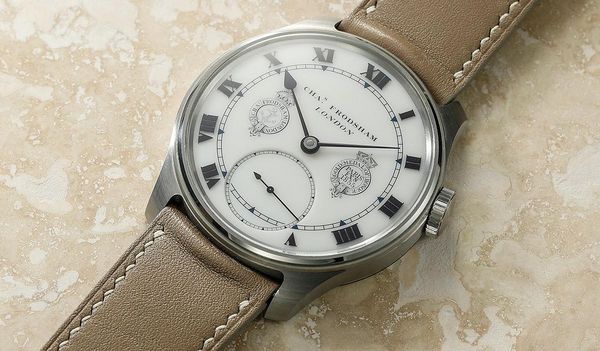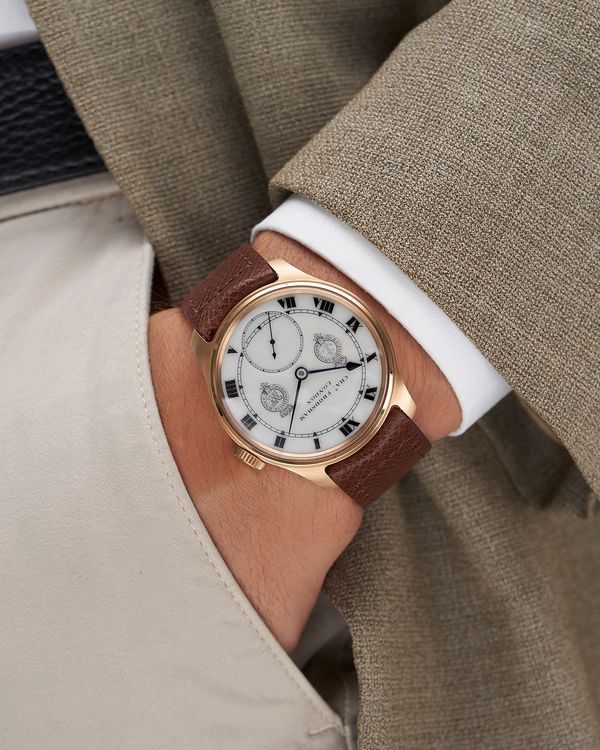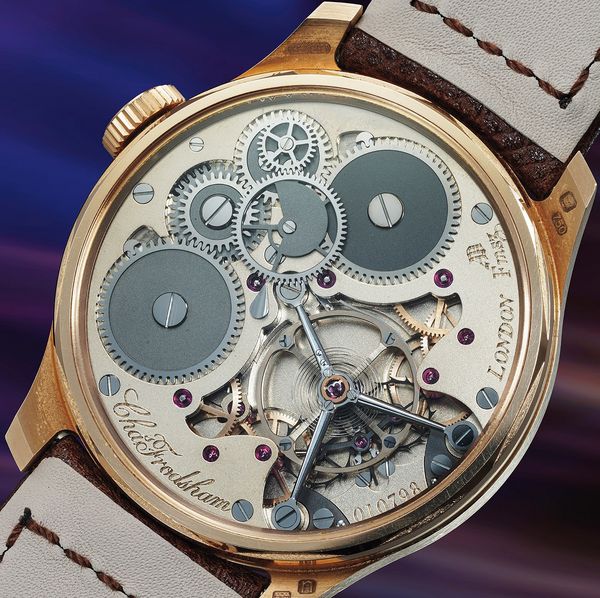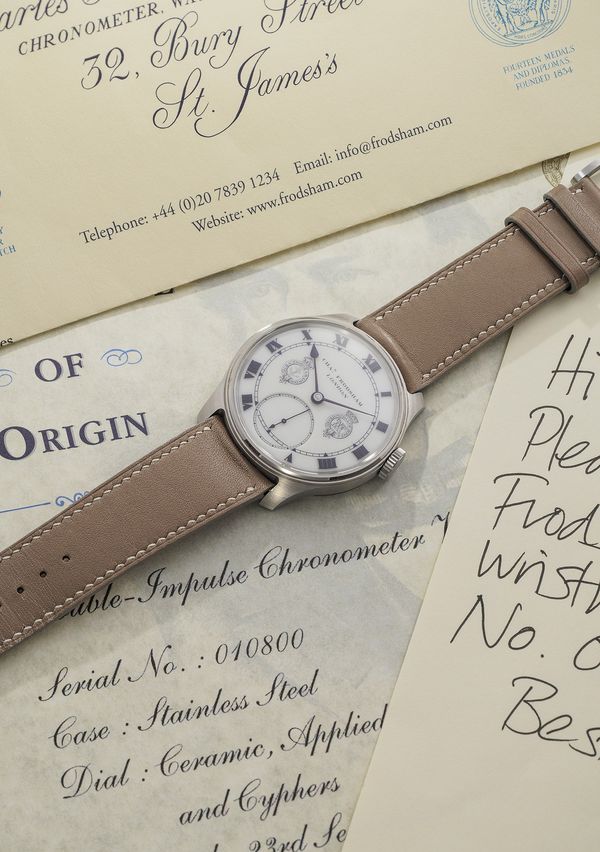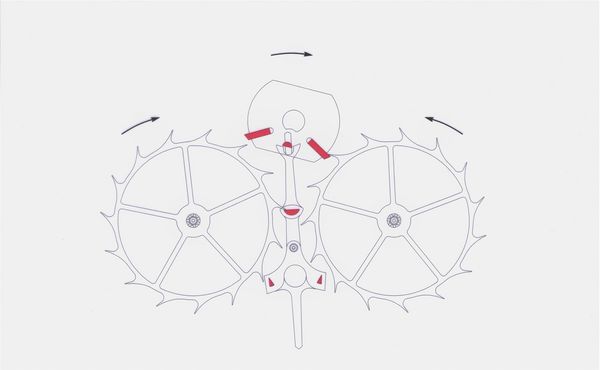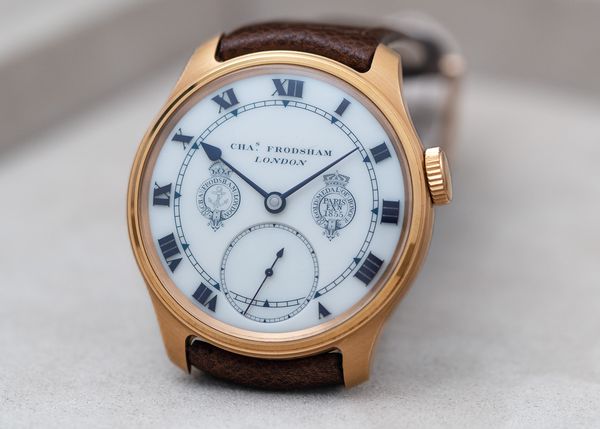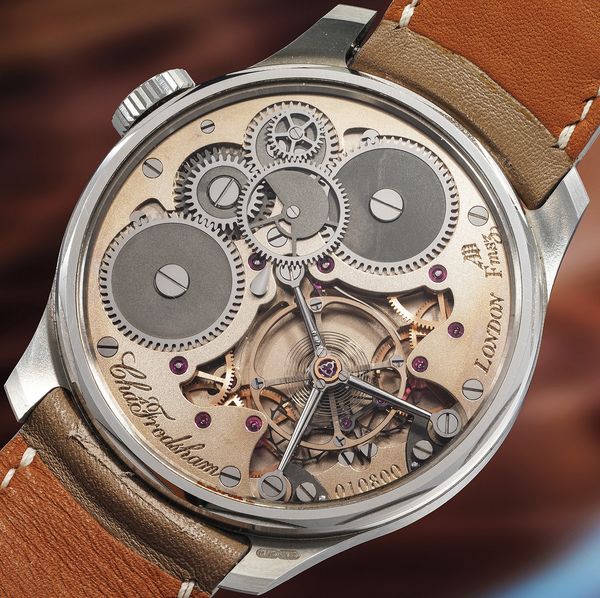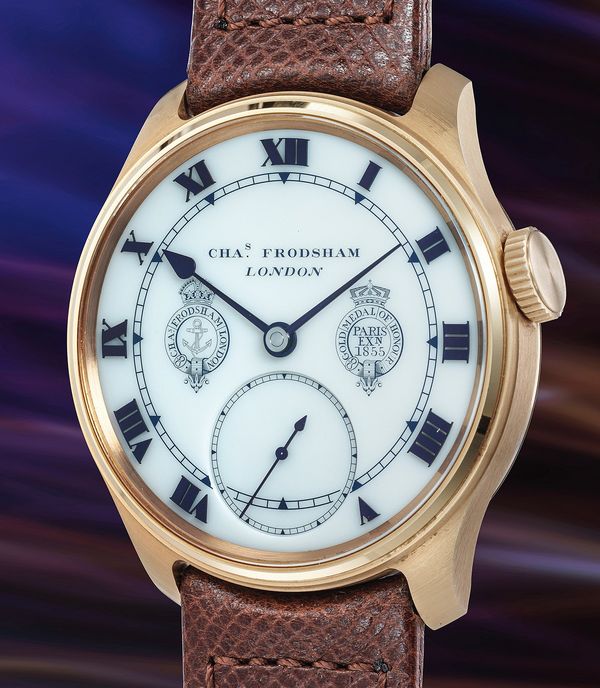Our first live auction of 2024, the PHILLIPS Geneva Watch Auction: XIX, takes place on May 11 and 12, at the Hotel President, at Quai Wilson 47 in central Geneva. The auction includes more than 215 of the world's finest watches – and though we are loath to boast, we truly think it's one of the best catalogs we've ever put together. We'll be highlighting a number of the most interesting lots and stories featured in the sale over the next month, including the Charles Frodsham Double Impulse Chronometer (lot 183) featured below.
– By Logan Baker
One of the most groundbreaking and exciting developments in watchmaking this century was quietly announced just over six years ago.
It didn’t come from the Vallée de Joux, or anywhere else in Switzerland. Nor did it emerge in Japan or Germany – the other two countries commonly thought of when it comes to mechanical watchmaking in the 21st century.
No, it came from an adress close to Buckingham Palace, in London.
This is where the gallery of the historic English chronometer maker, Charles Frodsham & Co. Ltd., has been since 1996.
The firm is the longest continuous trading firm of chronometer manufacturers in the world, dating back to 1834, when Charles Frodsham began his work in chronometer production.
Frodsham’s business, in his lifetime, was focused on the production of marine chronometers, highly precise pocket watches, and clockmaking.
Technology evolves in time, but the Frodsham business handled the decline of the once-leading English horological industry better than many of its contemporaries. The production of carriage and other domestic clocks during the 20th century attracted the attention of a number of prominent admirers, including the British Royal Family.
The business is now owned and operated by Richard Stenning and Philip Whyte, who lead a small team in providing restoration, service, and repair services to the owners of original Frodsham watches, clocks and chronometers.
Additionally, the Frodsham team has received commissions for the authentic recreation of some of the most important timekeeping devices in human history – John Harrison’s H3 and H4 marine timekeeper.
The latter was originally started by the esteemed English watchmaker Derek Pratt (best known for his work at Urban Jürgensen starting in the 1950s), who brought the project to the Frodsham team shortly before his unfortunate early death in 2009. The reconstruction was completed in 2014.
Pratt’s influence on Frodsham’s contemporary evolution can't be understated.
A suggestion made by the late watchmaker in the early 2000s is what led to the completion of the Charles Frodsham Double Impulse Chronometer wristwatch in 2018, the firm’s first commercially available wristwatch – but even more importantly, it was the first wristwatch to effectively miniaturize the escapement, an ideal that had long eluded George Daniels, the venerable 20th century watchmaker who used a similar, larger approach to the regulation of his legendary Space Traveller pocket watch.
The Charles Frodsham Double Impulse Chronometer operates with precision without requiring the use of lubricant in the escapement, something that places the wristwatch in contrast with practically every other mechanical timekeeper produced in horological history.
Daniels had envisioned his concept of the double-impulse escapement as an antidote to the tyranny an improper movement lubrication can have on a watch's precision over long periods of time – and it worked!
His only issue, however, was that he was unable to develop an appropriate method to condense the total space taken up by the two gear train system to fit inside a wristwatch's movement.
But before we get to how exactly the Frodsham team was able to address the miniaturization issue, we need to go quite a bit further back in history, to the time of the one-and-only Abraham-Louis Breguet.
Breguet invented what is known as the "echappement naturel" in the early 19th century. The escapement's so-called "natural" ability was born from the use of a pair of escape wheels (rather than one) that were placed in a single gear train and which delivered their impulse to the balance directly without the need for oil or lubrication.
So watchmakers have been trying to identify ways to address the lubrication problem for literal centuries. The eventual flaw of the natural escapement, if you're curious, had to do with meshing issues that would occur due to small gaps between the gear teeth. These seemingly minor open spaces tended to decrease the amount of torque that's then placed on the secondary escape wheel, eventually creating a backlash effect and negatively impacting the timepiece's precision.
A number of contemporary watchmakers have claimed to solve this backlash issue – Kari Voutilainen, F.P. Journe, and Laurent Ferrier chief among them – but it's not quite that simple.
Historically, in a natural escapement, the gear train drives the escape wheel; then, on the same escape-wheel axis, there's an additional wheel that is in contact with the second escape wheel. Suddenly, a single gear train has to accelerate a total of four wheels instead of a single one like normal. And when the amount of wheels has doubled, the required energy quadruples to retain the same acceleration. In other words, a natural escapement requires 16 times the energy to achieve the same acceleration on four wheels that a single wheel would require.
The inertia of the escape and gear wheels combined with any amount of backlash in the gear teeth simply rendered Breguet's natural escapement too unstable for practical use.
George Daniels understood where Breguet had errored, and unlike the later 21st-century watchmakers, he deviated in his approach substantially.
Breguet (as well as Voutilainen, Journe, and Ferrier) all use a single gear train in order to drive the natural escapement; the first escape wheel directly drives a second escape wheel. What Daniels did back in the 1970s, however, was to introduce two separate escape wheels, each independently driven by two independent gear trains and two independent mainsprings.
Daniels also borrowed from another form of early escapement design when he realized his independent double wheel escapement inside the Space Traveller pocket watch – the detent. It requires zero lubrication – one of the primary goals of the natural escapement – and is fantastically efficient, given that the impulse is given directly to the balance by the escape wheel. However, in its standard form, it's also dangerously susceptible to shocks.
The final version of Daniels' escapement construction utilized separate-but-equal escape wheels, mainspring barrels, and gear trains, with a detent managing the locking function.
Where the natural escapement requires four wheels all meshed and working together at all times, the Daniels' approach only has a single wheel in motion at any given moment.
The Independent Double Wheel Escapement, as envisioned by George Daniels, was nearly perfect. Its sole point of failure to make it wristwatch size menat the 2-train movement needed a large diameter case, which is the 1970s was most unfashionable.
And for a long time, he was correct.
It took Frodsham 16 years of experimentation (while also working on other projects, such as the Harrison H4 recreations), but Charles Frodsham's Double Impulse Chronometer wristwatch was finally revealed to the world in 2018.
The solution they discovered requires the use of effectively every millimeter of space in the movement architecture to consolidate the two symmetrical gear trains. A special safety brake is positioned alongside the balance wheel ensures the trains remain synchronized. This brake also requires the movement to be fully wound before the watch begins to run. In addition, an epicyclic differential in the winding work serves as an up/down mechanism to indicate the watch's 41-hour power reserve.
Similar to Daniels' approach in the Space Traveller, a small, lightweight titanium detent is placed between the two escape wheels, allowing the whole system to operate seamlessly without the use of lubricant or oil.
Charles Frodsham produces between 10 and 12 examples of the Double Impulse Chronometer every year, with a lengthy waitlist. One stainless steel example dated to 2019, however, is included in the upcoming Phillips Geneva Watch Auction: XIX. It's lot 183 in the catalog, carrying an estimate between CHF 100,000 and 200,000.
The only previous Double Impulse Chronometer to previously sell at a Phillips auction came last November, at Phillips Geneva, when an 18k pink gold example from 2019 soared past our pre-sale estimate, eventually arriving at an impressive sum of CHF 317,500.
You can learn more, place a bid, and view the entire Geneva Watch Auction: XIX catalog right here.
About Phillips In Association With Bacs & Russo
The team of specialists at PHILLIPS Watches is dedicated to an uncompromised approach to quality, transparency, and client service. Phillips in Association with Bacs & Russo holds the world record for the most successful watch auction, with its Geneva Watch Auction: XIV having realized $74.5 million in 2021. Over the course of 2021 and 2022, the company sold 100% of the watches offered, a first in the industry, resulting in the highest annual total in history across all the auction houses at $227 million.
About Logan Baker
Logan has spent the past decade reporting on every aspect of the watch business. He joined Phillips in Association with Bacs & Russo at the start of 2023 as the department's Senior Editorial Manager. He splits his time between New York and Geneva.
Recommended Reading
The Enduring Appeal Of Wolf’s Teeth Gearing In Fine Watchmaking
Andreas Strehler Is Your Favorite Watchmaker's Favorite Watchmaker
